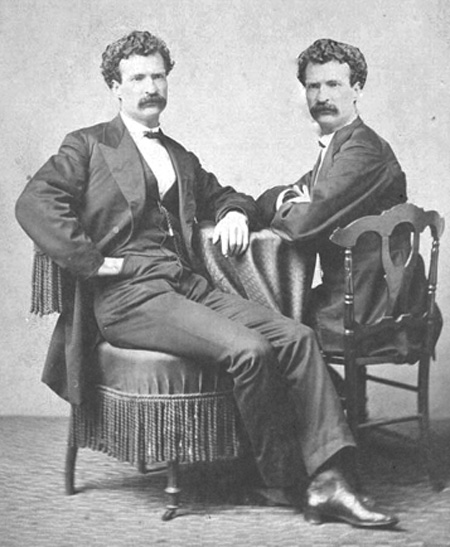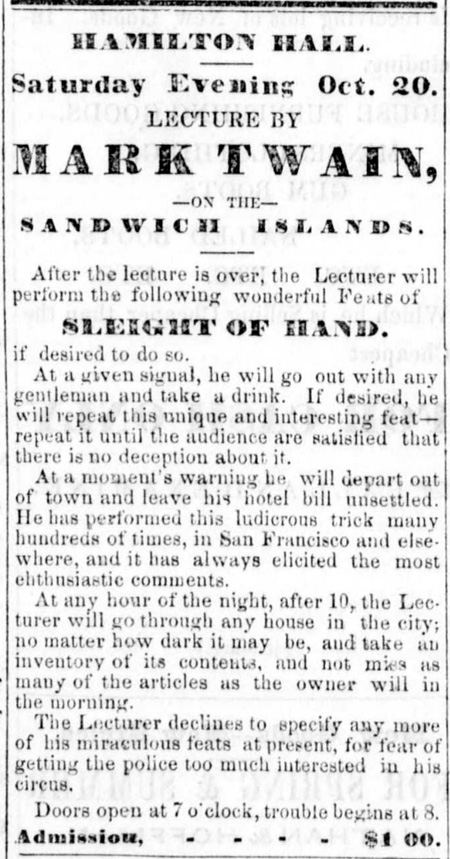Quotations | Newspaper
Articles | Special Features | Links | Search
SPECIAL
FEATURE
by Leslie Myrick
© February 2022
"Mark Twain"
in Wellington, Ohio:
A Flesh and Blood Double
in the Western Reserve, 1868

Photo of Mark
Twain used and altered with permission of
the Mark Twain Papers.
On 16 November
1868 the Cleveland Daily Herald published on the front page a humorous
letter entitled "A Mystery," concerning the far-flung escapades
of an unruly "spectral Double"(1).
One of the purposes of this piece, written by Mark Twain, was to advertise
the inaugural lecture of his Eastern "American Vandal Abroad" tour
scheduled for the following evening in Case Hall, Cleveland's new cultural
center (2). Twain reports that this
double, who had previously haunted him in California, having borrowed money
and left boarding-house bills unpaid there, had subsequently moved on to Idaho,
where he lectured on "The Moral Impossibility of Doughnuts" in the
town of Satan's Delight. Recently the double had made his way to Ohio, following
a stint in Wisconsin, where his crimes had escalated to include public intoxication,
swindling lecture audiences, and horse-thievery:
|
Last June, when I was lecturing in California, my Double was lecturing in Ohio and Wisconsin. And It was leaving Its bills unsettled, and thereby ruining Its own good name and mine too. About this time It fell into the habit of getting persistently and eternally drunk-a thing which I always considered disgraceful in a ghost. It appeared in Cincinnati and advertised Itself to lecture on the Holy Land. But it was just as prompt as ever about not paying its bills. I shall hear from Cincinnati shortly I suppose. Ah, how the enterprises of this dread, mysterious Being torture me. It appeared in other Ohio cities, and claimed and received those fraternal kindnesses and attentions at the hands of my brother journalists which It probably knew were never denied me when I so behaved myself as to be worthy of them; It advertised Itself to lecture and didn't; It got supernaturally drunk at other people's expense; It continued its relentless war upon helpless and unoffending boarding-houses. It came to Cleveland at last and introduced Itself at the Leader and Plain Dealer and volunteered in the kindest manner to write some flaming puffs of Itself. It introduced Itself at one of the principal hotels and swindled the landlord. It introduced Itself at the chief theatre, and was kindly and politely furnished with a private box by the gentlemanly manager. It introduced itself to various business men and asked favors of them. It kept itself more imposingly and magnificently intoxicated than ever a spectre did before, and It closed Its splendid career by failing to recognize the photograph of an old and well-beloved comrade of mine, and so was at once announced as an imposter. It then departed from Cleveland and traveled northward, and the first chance It got It stole a horse. I have longed in vain that It would kill a man and get hanged. Ah, why won't It? |
The mystery of this particular double, according to Twain--with an ironic wink at his own Pacific Slope reputation--is that a double usually replicates the behavior of its original, but this one's behavior was, as he claimed, diametrically opposed to Twain's:
| It gets intoxicated-I do not. It steals horses-I do not. It imposes on theatre managers-I never do. It lies-I never do. It swindles landlords-I never get a chance. |
During his western sojourn in Nevada and California Mark Twain had plenty of help from both allies and detractors in constructing an outrageous reputation as a hard-drinking, dead-heading, loose-living Sagebrush bohemian (3). Just two years earlier Twain himself had given a flaming puff to his own "bad boy" persona by publishing an advertising notice for an upcoming lecture in Grass Valley, California in which he attributed several of the Ohio double's vices--intoxication, swindling boarding-house owners, thievery--to himself:
(Grass Valley Daily Union, 18 October 1866, 2)

As Jeffrey Steinbrink noted in his book Getting to Be Mark Twain (1991), the years 1867-1869 were a period in which Clemens was heavily revising not only the manuscript of Innocents Abroad, but also, in light of his courtship of Olivia Langdon, his own reputation. It would be fair to say that "A Mystery" can be construed as an explicit repudiation of his bohemian self-fashioning (somewhere between con-man and prankster) as exemplified by the Grass Valley Daily Union advertisement, which was widely reprinted in late 1866 and early 1867.
Twain's Herald letter, "A Mystery," which begins as a ghost story, devolves in a series of postscripts into a report of the misadventures of a common swindler who passed himself off as Mark Twain in several Ohio cities--nothing more than "a very ordinary flesh and blood young man … a rascal by nature, instinct and education, and a very poor sort of rascal at that." However, editorial commentary in the "Notes and Comments" column of the Herald of the same date, most likely by local editor J. H. A. Bone, offers corroboration that there was, in fact, a Mark Twain impostor in Cleveland: "So far as his [Twain's] statement refers to proceedings in this city, we know it to be correct, for there was a bogus 'Twain' disporting himself here a few months since, but he soon found the neighborhood unhealthy."
Herald publisher Abel W. Fairbanks, husband of Mary Mason Fairbanks, with whom Clemens had traveled to the Holy Land on the SS Quaker City in 1867, likely made Clemens aware of the story of the Mark Twain impostor active in Ohio that summer. Fairbanks had the opportunity to relate the story to Clemens--Clemens had socialized with the Fairbanks family in September 1868, along with Charley Langdon, and again in November for several days before Clemens's lecture. Fairbanks had access not only to local papers carrying the item, but access to the Herald's exchange papers. One of Fairbanks's exchange papers from Milwaukee, the Semi-Weekly Wisconsin, reported: "A bogus Mark Twain has been gulling people in Ohio ("Miscellaneous Items," 15 July 1868, 1). This Milwaukee news report might well have been the inspiration for Twain's placement of the double in Wisconsin en route to Ohio in "A Mystery" (4).
No reports of the impostor have been found in Fairbanks's own Daily Herald. The most comprehensive report of the Mark Twain double in Ohio appeared in June 1868 when the local editor of the Lorain County News filed the following anecdotal report of the impostor's misadventures in Wellington, a small town with a population of about 1200, located eight miles south of Oberlin and forty miles southwest of Cleveland.
|
Mark
Twain in Wellington.
(Lorain County News, 24 June 1868, 3) A few days since our town was electrified by the appearance of that notable wit and eccentric Mark Twain. His arrival was unheralded and his advent without pomp or circumstance. He found lodgings at the Wellington House where he "twoct" with the landlord and praised his genial countenance and his hash-smiled on the ladies and played with the "Dorg." His advent soon surrounded him with the dignitaries of the place. His pleasant manner his easy and graceful conversation soon secured him "Mark"ed attention and invitations to address the Sabbath school and the Grant Club; the former invitation being accepted and the latter declined on account of his being "on the other side."-But to satisfy those desiring to hear him on the rostrum he consented to deliver a free lecture at the Methodist Church on the following Thursday evening entitled "Travels in the Holy Land." One of the leading members of our "City Government" invited him to tea remarking at the same time that a lady from California was at his house whose husband knew him well-the hour was set, the landlord was engaged "to show him up." Other guests were invited to assist in the conversation and in despatching the rich viands of the table. The hour arrived as did the guests-the soup was cooling and the "Tea was drawing." Anxiety was depicted on every countenance. Mark did not appear; he had suddenly thought of his manuscript left with his agent at Cincinnati-better disappoint a private party than the new church crowded with people to hear of the Holy Land from the lips of such an illustrious traveler. The trial was great-visions of mock turtle soup and chicken flitted before his appetite-duty conquers-his reluctant feet lifted him into the car and soon the place and people that had so lately known him knew him no more. In his haste he forgot his bill at the Hotel and five cents for a collar at Shrier's. Quiet
reigns-'mum' is on every mouth. Thursday evening arrives-the flattering
notice of the lecture and Mark's dignified letter in the [Wellington]
Enterprise brings a large number from the surrounding country
to hear only the unwelcome sound "Sold[,] sold by a seedy, superannuated,
dilapidated, retired, played out circus clown." |
Written nearly a decade after the Cleveland heyday of Charles Farrar Browne--better known as Artemus Ward--whose local columns in the Cleveland Plain Dealer often made jokes of the latest local swindle, this long item contains a smattering of vernacular ("twoct," "dorg"), and was intended to be humorous, even if its humor fails to impress a modern reader. More to the point, it is likely that this account, or a reprinting of it, provided the building blocks for Twain's "Mystery": details such as the unpaid hotel bill, unfulfilled lecture promise, and the threat of the impostor's being unmasked by someone who knew Mark Twain. Cincinnati looms large in both versions: in "A Mystery" it is one of the impostor's main targets, in the place of Wellington: ("It appeared in Cincinnati and advertised itself to lecture on the Holy Land, but it was just as prompt as ever about not paying its bills."), but in the Lorain County account, the impostor high-tails it to Cincinnati when he realizes he is about to be found out. In examining "A Mystery" side by side with "Mark Twain in Wellington" we apparently have a recipe for the blending of ingredients from an imperfectly remembered newspaper report of a petty swindler's con into a typical Mark Twain hoax.
~~~~~
A
clipping of "A Mystery" from the Cleveland Daily Herald,
November 16, 1868 from
Mark Twain's scrapbook provided by Robert Hirst of the Mark Twain Papers.
 |
NOTES:
(1) I am grateful to Robert Hirst and Barbara Schmidt for helpful suggestions to improve this essay, as well as to Nicole M. Hayes, author of the 19thcenturywellington.wordpress.com blog, for information on Wellington, Ohio newspapers.
(2) "A Mystery," Cleveland Daily Herald, 16 November 1868, 1. For similar hoaxes in advance of a lecture, see "Explanatory," (St. Louis, Missouri) Daily Republican, 24 March 1867, 1 and "Mark Twain and John Smith," (Quincy, Illinois) Daily Herald, 9 April 1867, 4.
(3) See, for instance, John Paul (pseudonym for journalist Charles Henry Webb), "Letter from San Francisco [dateline 15 Nov 1865]," Sacramento Union, 17 November 1865, 2. He recounts under the heading "An Incident" that a mysterious stranger carrying a carpetbag, two empty bottles, and a Westphalian ham entered a boarding house, approached the desk, and was summarily chased off by the cashier armed with a blunderbuss. "The hypothesis that it was only Mark Twain stepping up to pay his board bill is scouted as too improbable to be worthy of a moment's consideration."
(4) Similar reports had previously appeared across the country in Fayette County Herald (Washington, Ohio), 2 July 1868, p. 2 and in New York in the Buffalo Express, 8 July 1868, p. 2.

